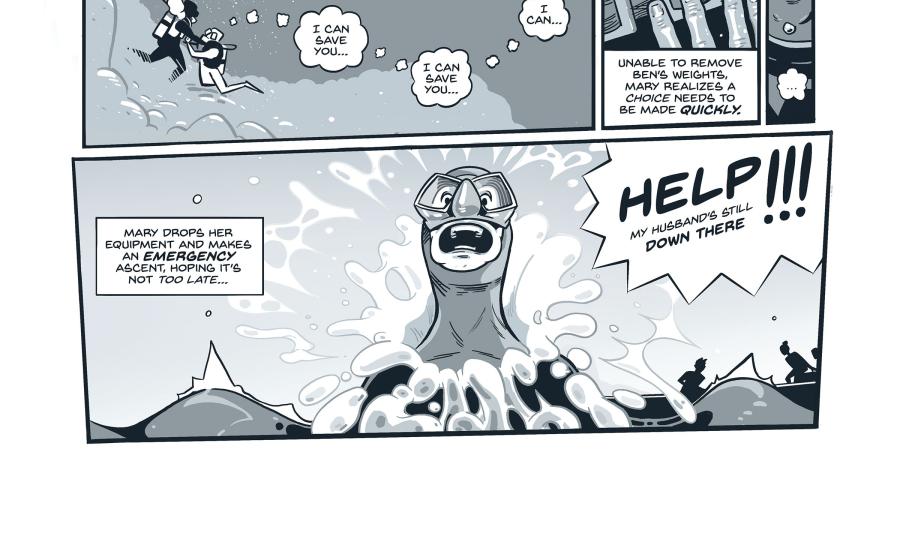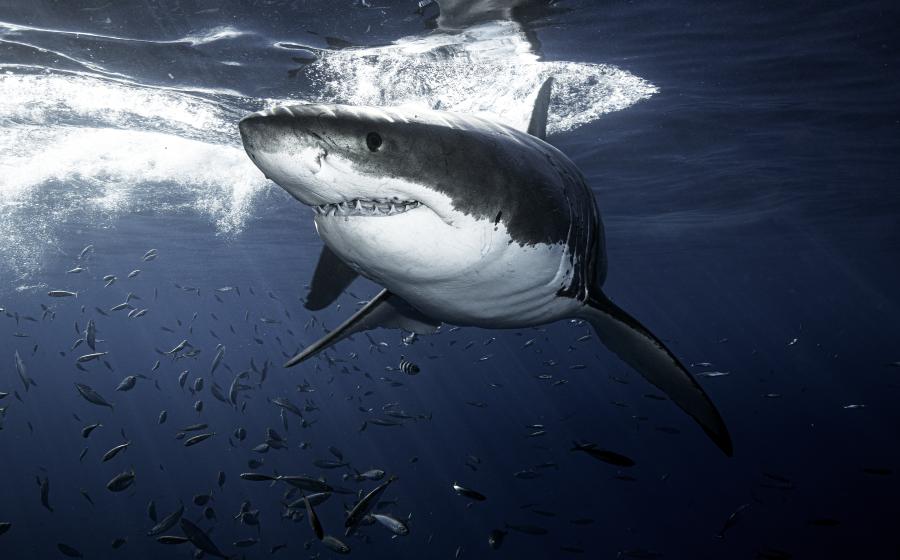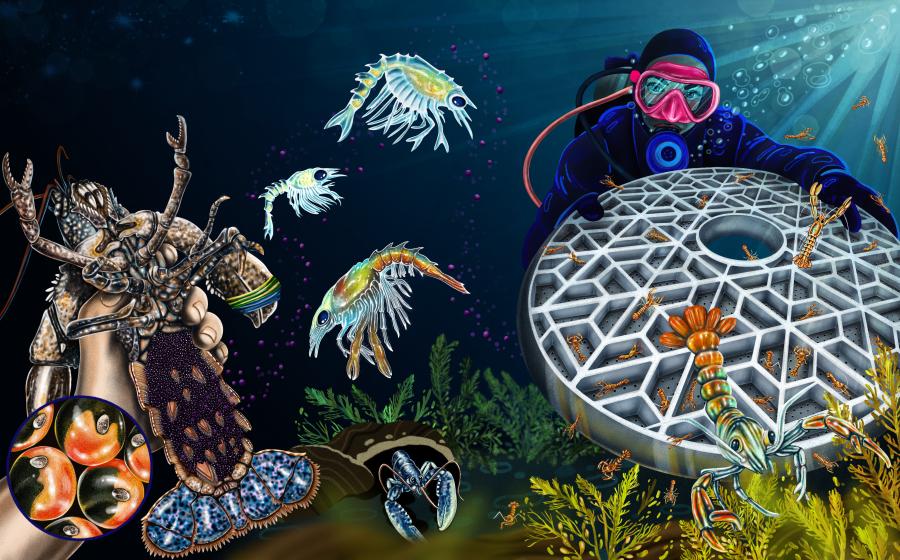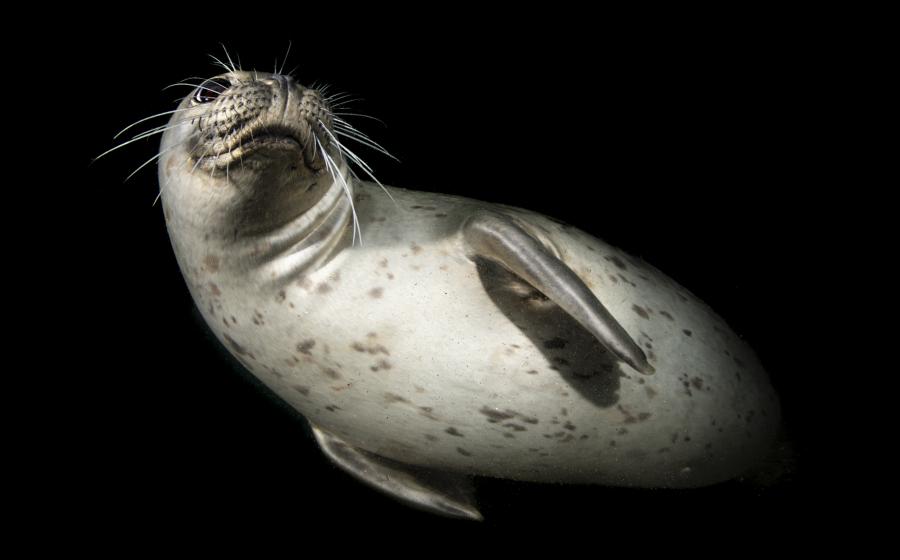Dream Duo: Diving in Maldives and Topside in Sri Lanka
PART 1: Male Atoll, Maldives
Light rays shimmer in the water column as I deflate my wing and drop weightless into the vast blue, stomach twisting with anticipation. I stretch my camera’s arms in a wide embrace, turn on my strobes and finetune the settings. Beside me, my cousins mirror my descent. Keagan gives me a calm “OK” signal, while Kelcey flips an exuberant shaka, her long blond braid streaming behind her.

Candice LandauManta rays gather at Maafushi Rocks, hoping the local wrasse will have a hankering for the parasites living on their bodies.
I still can’t quite believe they’re here diving with me. I haven’t seen them in years. When my parents, sisters and I emigrated from South Africa, leaving my extended family behind, they were still kids. Today, the more than 10-year age difference feels like nothing. I close my eyes briefly, tearing up with emotion, willing myself not to cry a contact lens out of place.
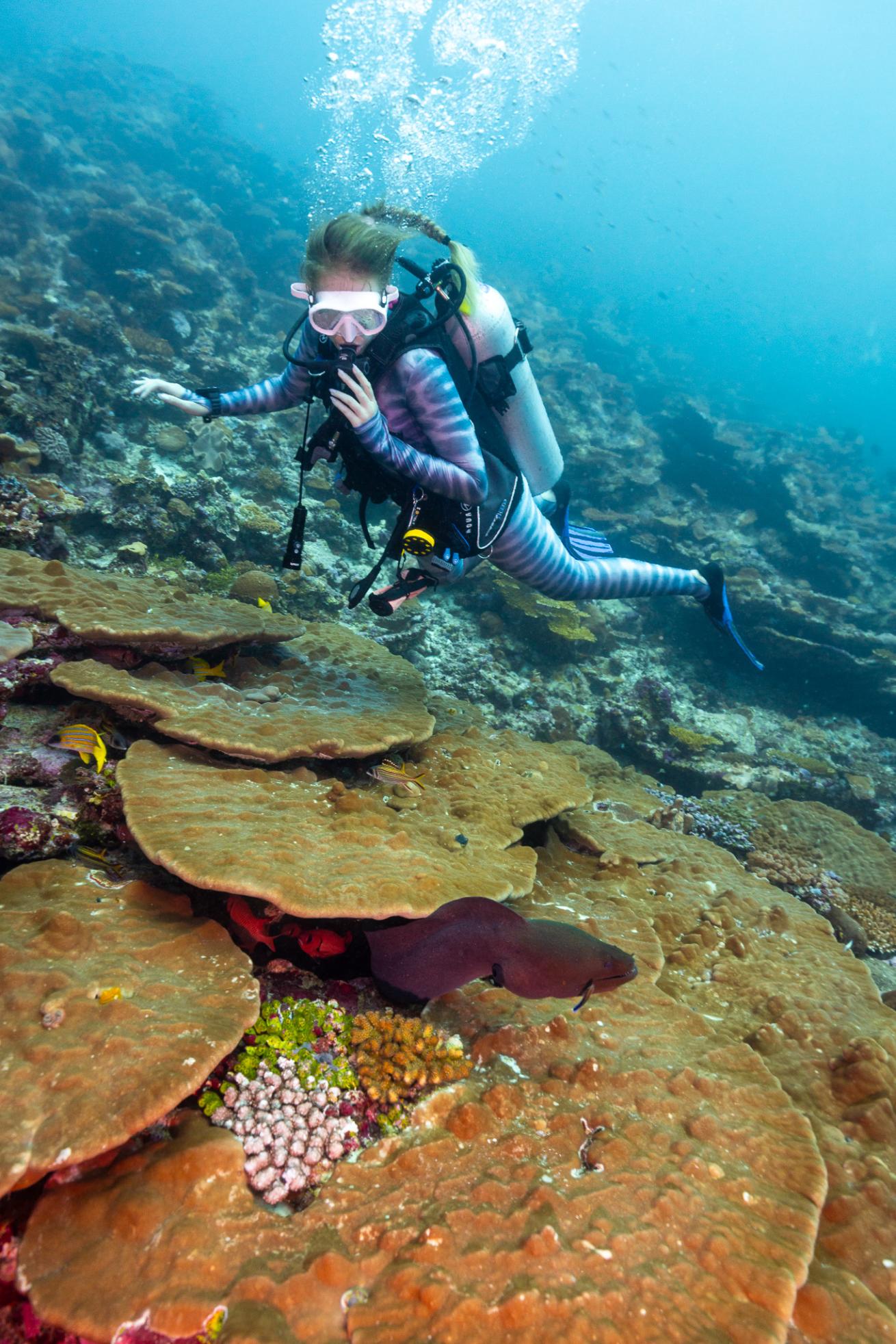
Candice LandauOne of the best ways to bond with family living across the globe is to meet up for a dive adventure.
We’re at one of the Maldives’ most iconic dive spots: a manta ray cleaning station called Maafushi Rocks. Unlike the nighttime manta dive we’ll do later in the week, this one is a little more natural—no staged lights to bring in plankton and therefore mantas. It’s a spot these elasmobranchs return to of their own accord in search of wrasse, more commonly known as cleaner fish.
As the reef ripples into shape, I think how funny it is that we’re flocking to watch what is essentially a giant deworming spectacle. Above and below us, the mantas glide by, allowing the cleaner fish to dip into their mouths and gills and pass over their bodies, removing parasites.
The site looks a bit like a terraced paddy field, rising in layers of coral, fish near the bottom and mantas on top. Our group settles close to the sand, looking up as the mantas swoop by. Keeping us company are large schools of bluestripe snapper. Like the sharks in the Maldives, they are unperturbed by our presence and are almost more mesmerizing than the mantas themselves, their vibrant colors as hard to look away from as a printed illusion. I can’t help but photograph them as my primary subject, with the mantas dotting the background.

Candice LandauMy first shot of a harlequin shrimp.
Kelcey is as overwhelmed by the spectacle as I feel and points excitedly at a remora that has strayed too far from its manta, her wide blue eyes conveying the same wonder I feel. Mickael, my new French dive buddy, is smiling—I can see it in his eyes. And then, a tap on my shoulder. Keagan is on a reef hook behind me, carefully staying off the bottom and out of the way of the mantas.
For a newer diver, he’s surprisingly good with his buoyancy. He’s also an excellent critter spotter. He directs my attention to a turtle the size of a small coffee table. We watch as it uses its beaklike mouth to tear chunks of seaweed and algae from the rocks. After a couple of minutes, our dive guide, Ziyad, points to a pale leaffish, nestled in pink algae. Its appearance is somewhat prehistoric, with a long dorsal fin reminiscent of a dinosaur’s ridge. Not the best color disguise but a great shot!
Related Reading: How to Travel With a Blue Mind
Introduce your friends to diving and the world's largest community of ocean lovers.
Give 15% off PADI OWD course, receive a free 30-day Scuba Diving magazine and PADI Club membership (and a new dive buddy.) Click here to learn more..

Candice LandauKeagan surfaces near the dhoni.
Thicker Than Water
A few days earlier, my family and I are busy having a reunion at Malé airport. It’s been years since we last saw one another, and we are a mix of nervous excitement, curiosity and heartfelt hugs.
My aunt Tracey, our nondiver but steadfast surface support, is ready to partake in whatever the adventure brings. Like Kelcey, she’s kitted out in sleek athleisure. After minutes in the airport we meet Aggressor’s cruise director, Shaker Mohamed.
We walk across the road and straight onto a dhoni—the boat that will take us out to our liveaboard, Maldives Aggressor II. It’s the most convenient and peculiar transport I’ve ever had from an airport. A diver’s paradise indeed.
All of the guests on the boat, with the exception of Mickael, a French fellow from Marseille, are traveling with someone they know in some form or fashion. My cousins make a natural buddy pair, so I’m quick to latch on to Mickael, and it isn’t long before we’re friends, teasing each other over cultural differences. He tells me it is sacrilegious to mix orange juice with Champagne, and I test out my now-rusty French vocabulary, much to his amusement.
WHEN I EMIGRATED FROM SOUTH AFRICA, LEAVING MY EXTENDED FAMILY BEHIND, MY COUSINS WERE STILL KIDS. TODAY, THE AGE DIFFERENCE HARDLY SEEMS TO MATTER.

Courtesy Shaker MohamedThe author with her Aquatica Digital camera setup ready to document the dive.
As we toast to the first night with a glass of sparkling wine and decadent chocolate mousse, Shaker introduces the crew and his partner, Brooke, also an instructor on the boat. Both are friendly, fun and down-to-earth. We also meet our dive guide for the trip—a tall Maldivian named Ziyad. Kelcey, Keagan, Mickael and I have been assigned to him.
In the Maldives, it’s especially beneficial to have a guide. They know what to point out at each site, and currents and boat traffic can make the diving more challenging than some people might be used to.

Candice LandauA spotted hawkfish poses.
Dive Dictionary
Diving in the Maldives isn’t quite like diving anywhere else. First, the underwater topography is different. Shaker explains the terminology we find appended to many dive site names: thila, giri and kandu.
Thilas are underwater pinnacles that rise dramatically from the seafloor, often teeming with vibrant corals and a diversity of marine life. These submerged formations create stunning vertical landscapes, with walls adorned in soft corals and sea fans swaying in the currents. Schools of colorful fish dart in and out of crevices, while larger pelagic species like reef sharks and barracudas patrol the deeper waters surrounding the thilas.
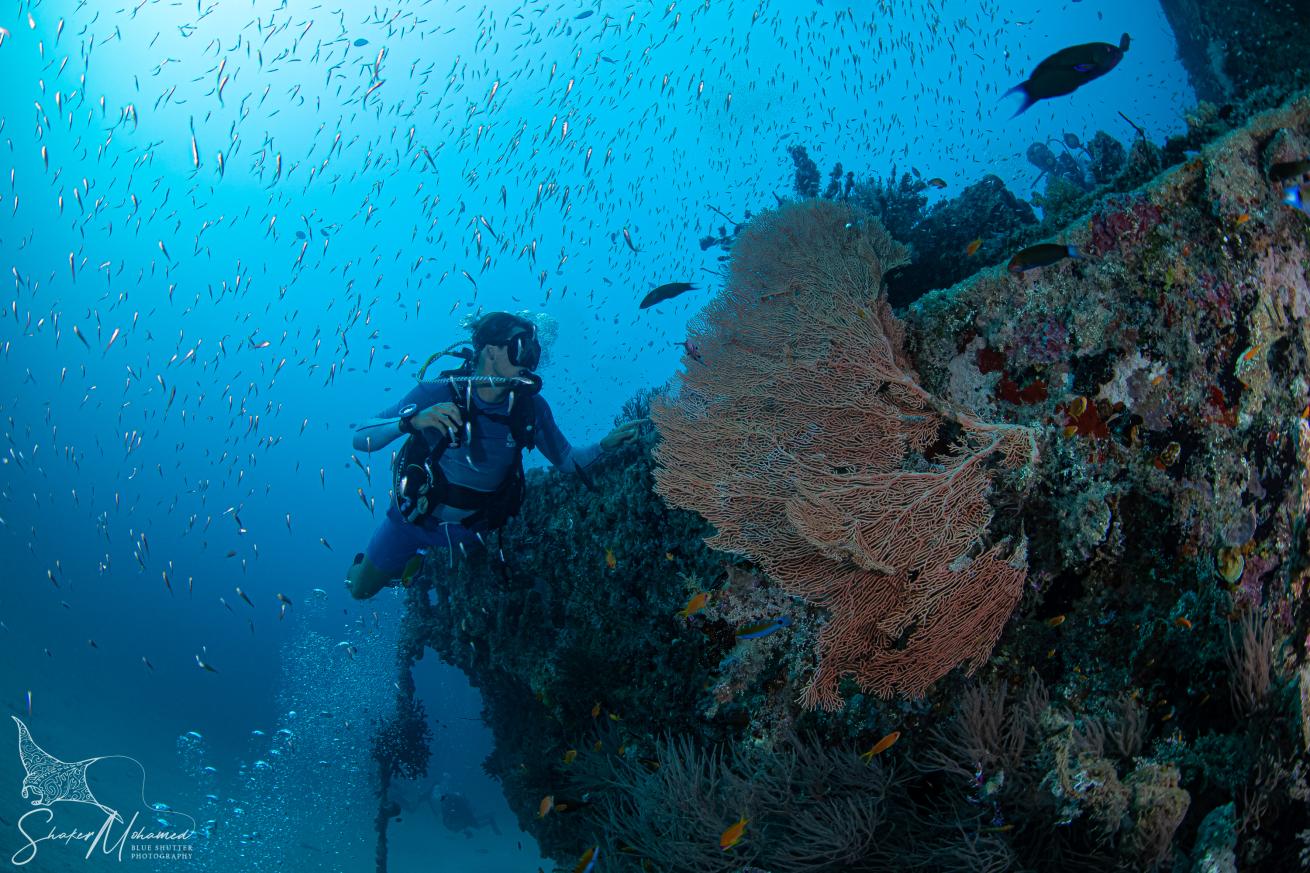
Courtesy Shaker MohamedDivers enjoy beautiful reefs and wrecks during their time aboard Maldives Aggressor.
Giris, on the other hand, are smaller coral heads or knolls that barely break the surface or remain just below it. These structures are like underwater oases, often attracting a variety of marine creatures seeking shelter and food. The shallow depths and abundant sunlight create perfect conditions for coral growth, resulting in a rich tapestry of hard and soft corals. Divers can explore these areas leisurely, marveling at the intricate details of the coral formations and the myriad tiny reef inhabitants.

Brooke PykeNurse sharks are common at Maldives dive sites.
Kandus are channels that cut through the atolls, creating natural highways for nutrient-rich currents. These channels are dynamic and exhilarating to dive, as the water movement attracts large schools of fish and pelagic species. Divers can drift along with the current, witnessing the bustling activity of marine life as they navigate these underwater thoroughfares. It’s not uncommon to encounter eagle rays gliding gracefully, tuna darting by, or even the occasional hammerhead shark cruising through the channel.
This distinctive topography, combined with the crystal-clear waters and rich biodiversity of the Maldives, makes diving here entirely unique.
One of the most exhilarating experiences is reef hook diving. Using reef hooks, we anchor ourselves against strong currents and watch as sharks patrol the waters. This technique allows us to stay in one place and observe the happenings without drifting away.
Related Reading: How to Photograph Eels
Real-Life Connection
The boat quickly becomes more than just the place we return to after each dive. It’s our moment out of time, a space where poor Wi-Fi helps foster great conversation. My cousins and I spend a lot of time on the top deck, either lying in the sun on the lounge chairs or immersed in the hot tub, catching up. The many seating areas also allow us to slowly get to know one another, and I am constantly returning to the open fridge to grab a Schweppes bitter lemon.
Shaker, with his curly gold-blond hair and teasing sense of humor, briefs us meticulously before each dive. He ensures we know what to expect, as well as how to navigate each site. Beside him, Brooke is a calming presence, her bright eyes reflecting an open mind and a kind heart. As an instructor, she patiently guides Kelcey through both her PADI Advanced Open Water and nitrox courses.
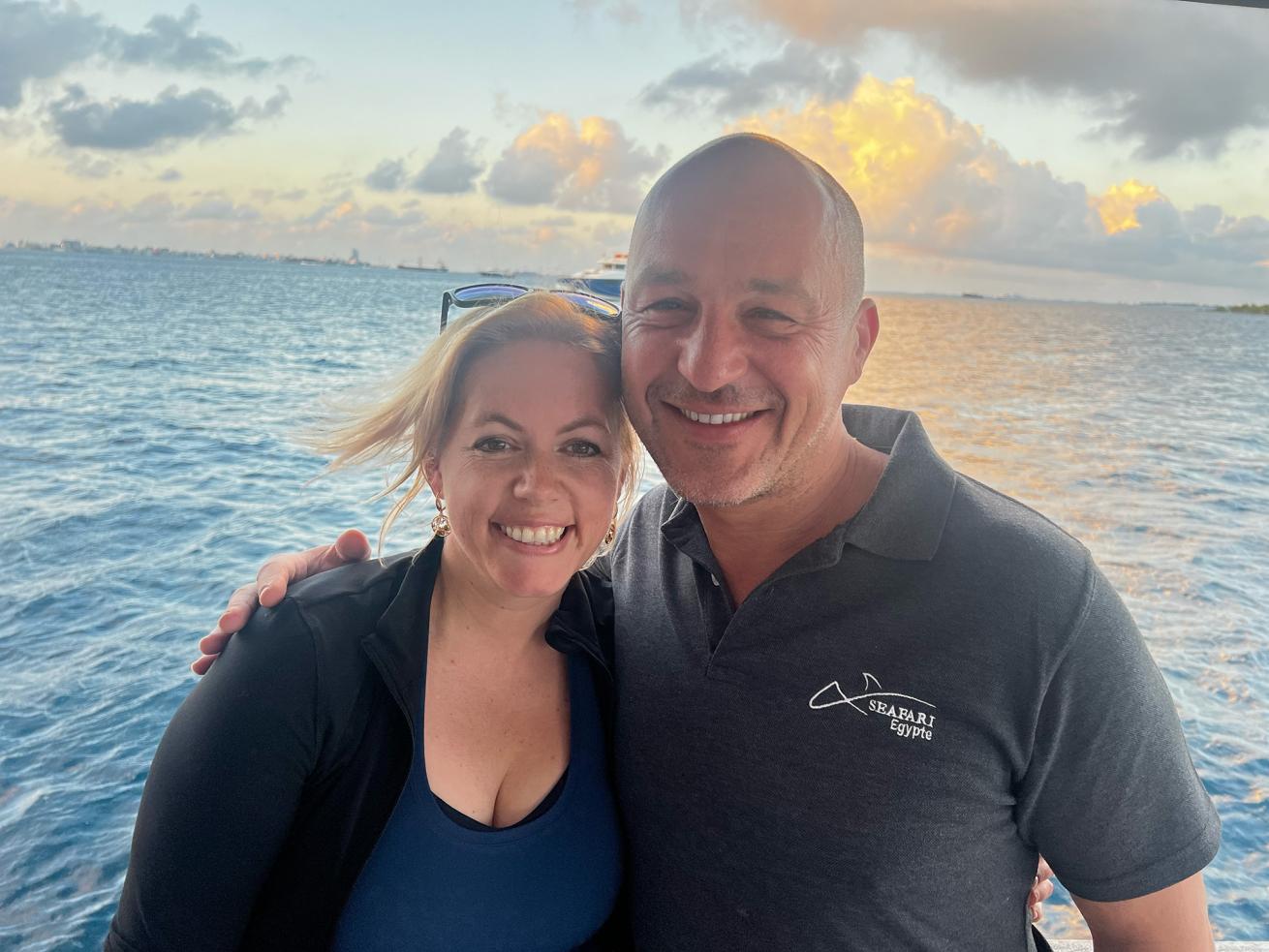
Candice LandauLiveaboards are a great place to make new dive friends from around the world.
Each evening, we gather in the dining area. I’m always curious to see what Chef Isuru has cooked up. I’ve let him know I’m vegetarian and that I love spicy food. Unlike many of the other guests, I’m not interested in burgers and fries. I want food I can’t easily get at home, and he is thrilled to oblige. The curries have my mouth watering, as do the sides of decadent hot sauce and ornate desserts.
At night, Mickael and I often find ourselves on the dive deck, glasses of wine in hand, discussing everything from the nightlife in Marseille to our favorite moments from the day’s dives. These conversations cement a friendship that, much like the bonds with my cousins, feels destined to last. We agree we’d like to return next year and dive the southern region of this sprawling archipelago.

Candice LandauThe liveaboard crew prepares a feast on a nearby island on the penultimate night.
One of my favorite memories takes place on the second-to-last night. In the setting sun, the crew ferries us to a secluded island and we enjoy a feast that seems prepared for royalty. Spread on a long table is a smorgasbord of roasted meats, freshly caught fish, grilled vegetables, and an array of fruits and desserts. Improvised lanterns cast a warm glow as laughter and stories fill the air.
This is where I introduce Kelcey to drone flight. Setting her DJI drone atop the latest issue of Scuba Diving magazine, we ready for takeoff and rise above the island. Below us, the memory is imprinted in photograph, a glow of light and merriment surrounding the beautiful whale shark sculpture our crew has carved into the sand.
One Big Happy Family
Despite their relative dive inexperience, Keagan and Kelcey quickly adapt to the rhythms of liveaboard life. Keagan’s meticulous nature makes him a natural at spotting marine life, and he’s always pointing out subjects for my underwater photography—a moray eel peering curiously out from a rocky crevice, long glittering barracudas, and some of the biggest Napoleon fish I’ve ever seen, their scales a gradient of blues that make for easy camouflage in the tropical water.
Kelcey’s enthusiasm is infectious, and underwater I can barely keep track of her. I find myself thinking how grateful I am that Brooke has joined our team to buddy up with her. After all, with a camera in hand, I’m just about the slowest diver you could find.
The camaraderie extends beyond our family. Fellow divers share travel experiences. They ask what it’s like to work for PADI—a dream job—and they ask me about the best destinations I’ve traveled to. This, I tell them, is certainly one of them.
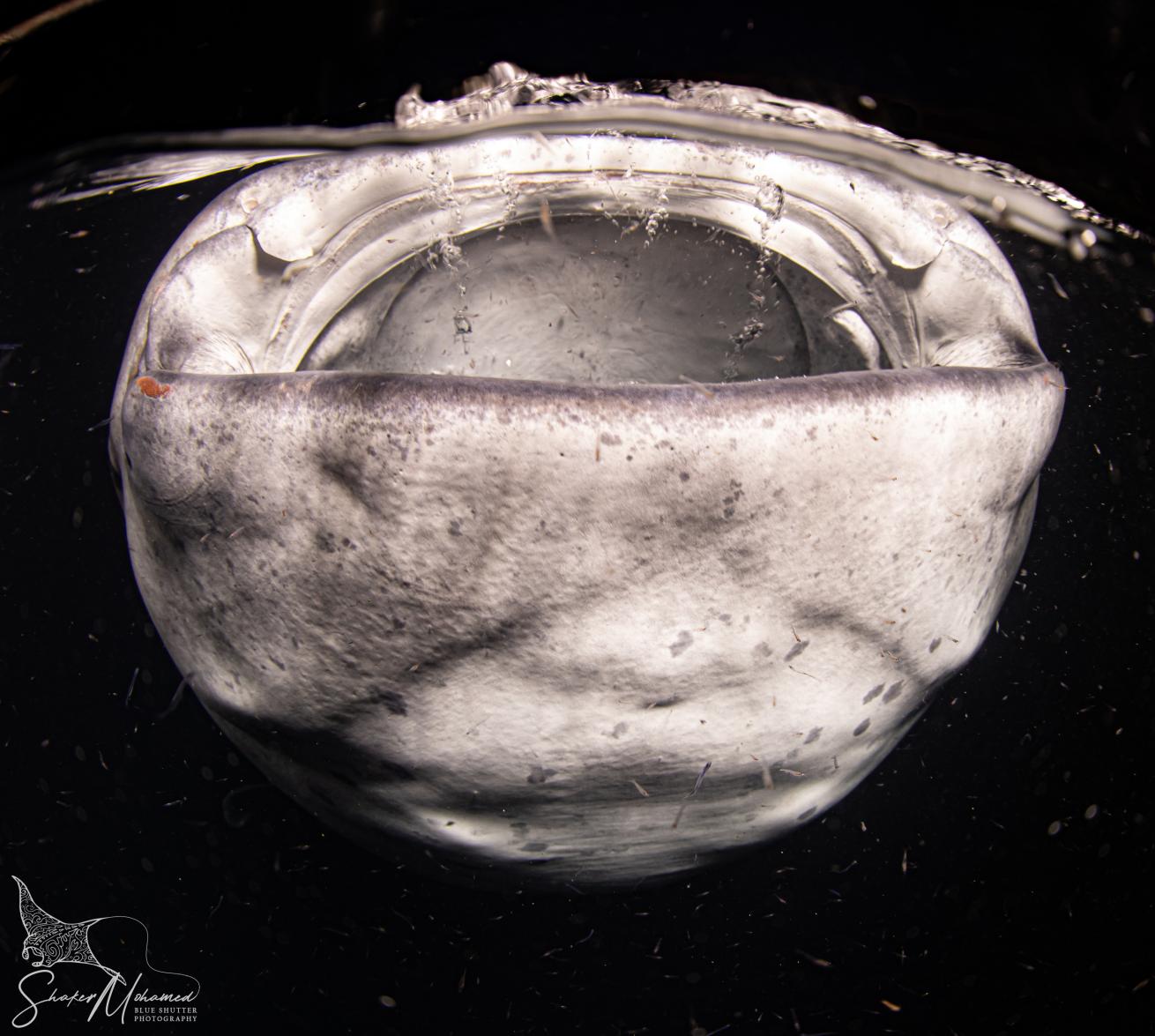
Courtesy Shaker MohamedWhale shark feeds at the surface at night.
Highlights Big And Small
The Maldives is renowned for its breathtaking underwater landscapes and vibrant marine life. Coral is still healthy, and big animal encounters frequent. In fact, we’re lucky not only to see a whale shark in the water on one of our dives (a first for me!) but to watch them come to the boat at night to feed in the light off the stern. I jump into the water fully clothed and snorkel a respectable distance away. Taking it all in beneath the star-studded sky, I can’t help but think that in this moment I am living my life to the fullest.
Nurse sharks and reef sharks are also regularly spotted on our dives, especially on dives that involve current. We see dozens of them drifting back and forth, an occasional curious batfish joining our group to see what we’re up to.
NEXT YEAR, WE’LL RETURN AND EXPLORE THE SOUTH ATOLLS. IT’S NO LONGER JUST A STATEMENT-IT’S A COMMITMENT.
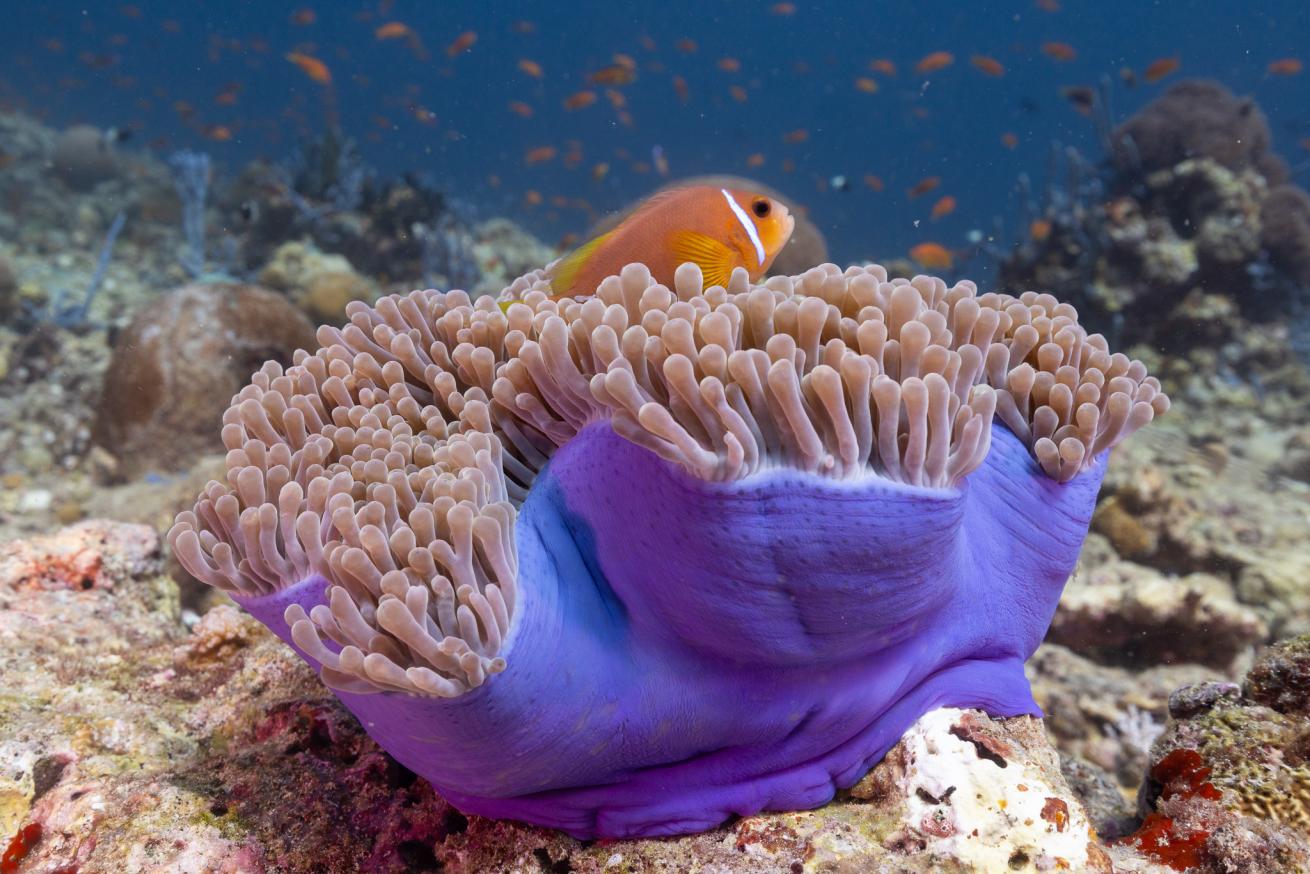
Candice LandauThe author's favorite fish to photograph in the Maldives.
Though it may not seem particularly novel, one of my favorite finds on a dive is an anemonefish, or in the case of the Maldives, what I like to refer to as a town of anemonefish, each with its own anemone home. The baby anemonefish are so cute I can’t take my eyes off them. Best of all, they’re curious about me too, popping in and out of sight to check me out.
On one of our safety stops, I’m enraptured by a school of Moorish idols that pattern the water column. Keagan and I spend much longer than the required three minutes in their hold. I know he feels the same fascination I do as he stretches his arms out to either side, mimicking a plane in flight. I use both hands to make a heart shape at him and he returns it, our signature underwater gesture when we’re feeling overwhelmed with awe.
Another special encounter happens on a wall dive. It’s a viewing point for sharks. Keagan is reefhooked into the rock while I am fighting the current in order to move about capturing photos. Suddenly I see Ziyad frantically waving me over. He points to an orange blob not 3 feet in front of Keagan. It has what can only be described as feet and an upside-down smile. I gasp. It’s a frogfish—the fish we’ve been searching for—and it’s a big one. Another first! Though it’s not exactly camouflaged, it’s so still that if Ziyad hadn’t pointed it out I’d have passed it by thinking it a sponge.
I recall my promise to Mickael. Next year, we’ll return and explore the southern atolls. It’s no longer just a hopeful statement—it’s a commitment.
Related Reading: 8 Best Places for Shark Encounters

Courtesy Shaker MohamedA frogfish sits calmly on the very edge of a steep drop-off, in spite of the current that has most divers using reef hooks.
Spotlight: Reef Hook Diving
Reef hook diving is a specialized technique used by divers to safely navigate and enjoy strong currents while exploring coral reefs. During a reef hookdive, divers use a sturdy hook attached to a length of line, which is then anchored into a stable area of dead coral or rock. Once secured, the diver can relax and maintain a stationary position, allowing the current to flow past them without the need to swim against it. This technique not only conserves energy but also provides an unparalleled vantage point to observe the bustling marine life that thrives in these nutrient-rich currents. Schools of fish, cruising sharks, and other pelagic species often come into view, offering an exhilarating and dynamic diving experience.

Candice LandauA moray eel peeks out into the current amid the thrum of anemonefish, anthias and swaying anemones.
Need To Know: Maldives
Operator
Aggressor Liveaboards (aggressor.com)
When To Go
The Maldives can be dived year-round, though currents may be strong in January and February. However, this is also when big animal activity is fantastic. Manta rays are seen throughout the year, with the best encounters occurring in May to November and whale sharks in April, May, October and November.
Conditions
Water temperatures range from 80 degrees in the wet season (May to November) to 86 degrees in the dry season (January to March). A 3 mm wetsuit is recommended.
Trip Info
Maldives Aggressor II runs three distinct itineraries: Best of Maldives (7 nights); Best of Northern Maldives-Lhaviyani (10 nights); Best of Maldives-Meemu (10 nights). The author’s trip was Best of Maldives. A port fee of $340 for a sevennight cruise or $425 for a 10-night cruise is due when settling the bill at the end of the trip.
PART 2: Sri Lanka
By the time the week has drawn to a close, I am ready for the next adventure, a safari and tour of Sri Lanka at one of Aggressor’s Signature Lodges, just over an hour’s plane ride away from Malé. Considering how close Sri Lanka is, it would be a missed opportunity not to visit after diving in the Maldives.

Candice LandauThe group explores Lankatilaka Temple and the ancient city of Polonnaruwa. Intricate stone carvings make it a cultural wonder.
While my cousins and aunt opt to stay in the tropics a little longer, relaxing in ocean bungalows directly on the water, I embark on the next leg of my journey, accompanied by members of Dive Army, an organized dive group that also happened to be booked on our liveaboard itinerary. The founders of Dive Army, Chris Adams and Sarah Sisco, are based in Maui, Hawaii. Over the years, they’ve attracted a loyal group of divers who opt to join them on trips all over the world. It’s a direct reflection of how the dive community becomes like family. You don’t just explore with them, you travel with them for life. Sarah tells me they added Sri Lanka to their group’s itinerary because they’d enjoyed it on a previous excursion, and Chris says this time he’s on the lookout for a sloth bear. Pam, a longtime friend of theirs, has her own mission. She’s on the hunt for Ceylon sapphires.
The drive north to the safari lodge takes a surprisingly long time—about four hours from the airport in Colombo. I’m grateful for this as it allows me to get a feel for the country. On the road, tuk-tuks, minibuses and cars wend skillfully by one another in controlled chaos, stray dogs trot alongside or lie directly on the pavement warming themselves, and locals line their crops on the road itself to dry, occasionally sweeping over them—I’ve never before seen this and am amazed people don’t drive over them. The thrum of life here is palpable.
Aggressor staff is going to be busing us to each of the destinations on our itinerary, and I make a point to sit up front so I can ask endless questions. Ruwan, our host and primary point of contact, buys us rambutans and we split them open in the bus. They’re a spiky red fruit with white flesh inside. They taste just like lychees. I’m thrilled—yet another fruit that’s hard to find stateside.
CONSIDERING HOW CLOSE SRI LANKA IS, IT WOULD BE A MISSED OPPORTUNITY NOT TO VISIT AFTER DIVING IN THE MALDIVES.
When we finally pull into camp, it’s late afternoon. We meet the rest of the staff, including our other key points of contact—Sampat, who will be our guide for many of the excursions, and Bandu, our primary contact at the lodge. They’re all very accommodating and quickly adapt to everybody’s varied desires, tweaking the itinerary and the meal plan to suit. The luxurious and spacious tents where we spend our nights are fully furnished and air-conditioned.
Into The Jungle
Our first excursion is an early morning safari in Wilpattu National Park. It’s like an African safari in that we clamber into open jeeps and drive through the park passing ponds and open grasslands before entering the dense forest. The soil here is a bright red, and peacocks, birds of prey and Sri Lankan spotted deer are abundant. We see a large troupe of macaques when we stop for breakfast. They’re cheekily climbing in and out of the jeeps on the hunt for food, even going so far as to open someone’s cooler. Though we don’t see leopards on this first excursion, we do see them later in the week when we return. They’re hard to spot, and we manage it only thanks to Sampat’s sharp eyes.

Candice LandauClockwise from top left: One of Aggressor’s Signature Lodges; Sri Lankan lunch on a lotus leaf; Cheryl and Candice sample the drinks; Asian elephants.
A Tour Through History
Among my favorite excursions are visits to Sigiriya Rock Palace and the ancient city of Polonnaruwa. Sigiriya, an imposing rock fortress nestled in central Sri Lanka, is often hailed as the eighth wonder of the world. This architectural marvel was built in the fifth century by King Kashyapa and stands atop a massive column of granite. The climb to the top involves navigating over 1,200 steps, which leaves our group tired, sweaty and ready for lunch.
Polonnaruwa, by contrast, is flat. Once the thriving capital of Ceylon during the 11th and 12th centuries, its ancient ruins and archaeological treasures suggest a history of sophistication and thoughtful urban planning. I find it beautiful in the same way ruined British castles are, though the scale here is vast by comparison.
After our hike up Sigiriya Rock Palace, we head to Minneriya National Park, home to the largest Asian elephant gathering. Though it’s more relaxing wending through the park in an open truck than climbing a fortress, it also admittedly has my nerves on edge. Some of the elephants come so close to the vehicles that I can’t help but wonder if they ever give them an experimental push. Of course, nothing like that happens, and I breathe a sigh of relief upon exiting. That night we explore the ancient city of Anuradhapura on the lookout this time for small, nocturnal primates called lorises. I am distracted by fireflies, bright red millipedes and the distant sound of chanting ringing in from the temples. It feels like I’ve stepped 1,000 years back in time.
By the end of the week I know I’ve barely scratched the surface. The country is captivating and culturally rich, especially if you love animals and archaeology as much as I do. The people also make it what it is, and they welcome us with unparalleled warmth. Though I get glimpses into Buddhist culture, the dominant religion here, I’ll need to return for the full picture. Still, something about this place feels like home.






